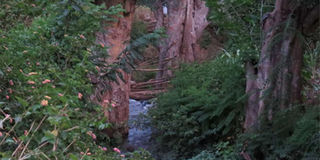The hills in the Rift

Plank over the furrow that drains into Arror River near Arror from the Cherangani Hills. PHOTO| RUPI MANGAT
What you need to know:
- By midday the heat is over-powering. We drive back to Arror, stopping on the banks of River Arror that drains into Kerio River.
- A group of Keiyo men stop to greet us. It’s a tough terrain with pasture and water closely guarded from the neighbouring Pokot.
- The men demonstrate their shooting skills with the bow and arrow, aiming at the hills a kilometre away.
Water gushes down the Cherangani Hills at Arror. It’s picturesque in the setting sun with the village kids escorting us to the centuries-old furrows that were dug by their ancestors for fresh water to reach the dry plains.
It’s mango season. Trees heave under the weight of the fruits everywhere with orchards of pawpaw trees. Herders herd their cattle up the slopes. The cows stop to drink fresh water flowing down a furrow. I cross a plank secured across River Arror, between two fig trees, that acts as a bridge.
“Look, the water comes from up there,” says Fennel Chelimo, a young Keiyo mother nursing her child. “It’s Moyeni Falls.”
It’s a whole day’s hike to the sheer slab of granite rock from where the water falls and is then channelled through the furrows. At this late hour, we only manage the lower slopes.
It’s a pleasant night and we stop for a meal of sukuma, chapatis and sweet tea at the local hotel. Lanterns lights the street that’s never seen tarmac.
In the first light of the day, the sun scorches the valley between the Cheranganis and the Tugen hills.
The colours are vivid and the birds amazing. Paul Kimani and George Muigai – both keen birders from the slopes of the Aberdares and actively monitoring the two endangered species there – Sharpe’s longclaw and Grey crowned cranes – point out colour-clad birds within a few feet of us.
There’s a Double-toothed barbet in scarlet red-breast and black at its nest in the hole of a tree, Casqued hornbills, Grey hornbills, Red and Yellow barbet and the one of the two gonoleks we have in Kenya, the Black-headed with a vivid red chest.
A few minutes’ drive from Arror, we follow the course of the Kerio. It’s a beautiful acacia woodland of tortilis in white flower.
We stop by the sturdy Teren bridge over the Kerio. Beneath it, the gorge reveals grey boulders hollowed by the force of water when in full flow to reach the world’s largest permanent lake in a desert and the world’s largest alkaline lake, Turkana.
It’s dry season. The Kerio has little water in it. The gorge is impressive with fishers carefully tackling the uneven terrain to bait fish.
They come out with a foot-long carp, clean the stomach and use the entrails to lure the mudfish. While they look for fish to take home, the guys find a fish that’s only found in the rivers of Kerio – the Kerio sucker-mouth catfish that’s just a few inches long.
By midday the heat is over-powering. We drive back to Arror, stopping on the banks of River Arror that drains into Kerio River.
A group of Keiyo men stop to greet us. It’s a tough terrain with pasture and water closely guarded from the neighbouring Pokot. The men demonstrate their shooting skills with the bow and arrow, aiming at the hills a kilometre away.
The road further north along the Cheranganis, leads to Tot while another upwards to Kapsowar. The desert rose is in bloom of lush pink flowers breaking the monotony of the thorn trees and succulents. Orchids grow in the shade of the flat-topped acacias and towering red-earth termite mounds stand like castles of clay.
The drive back on the rough road past the clan lands of the Keiyo and Rimoi national reserve brings us back to Biretwo on the main road. It’s busy with the Keiyo women selling all the fruits in season.
We’re on the way back home to Nairobi, passing the daring divers of Cheploge Gorge and up the winding road to Kabarnet. The road continues down the escarpment with amazing views of the Tugen hills and the freshwater Lake Baringo lying on the floor of the Great Rift Valley.
At Mogotio where the equator passes, driving past the sisal plantations and honey vendors, herds of well-fed donkeys are led to the slaughterhouse – Goldox, a Chinese operation.
www.rupitheafricantrotter.wordpress.com




